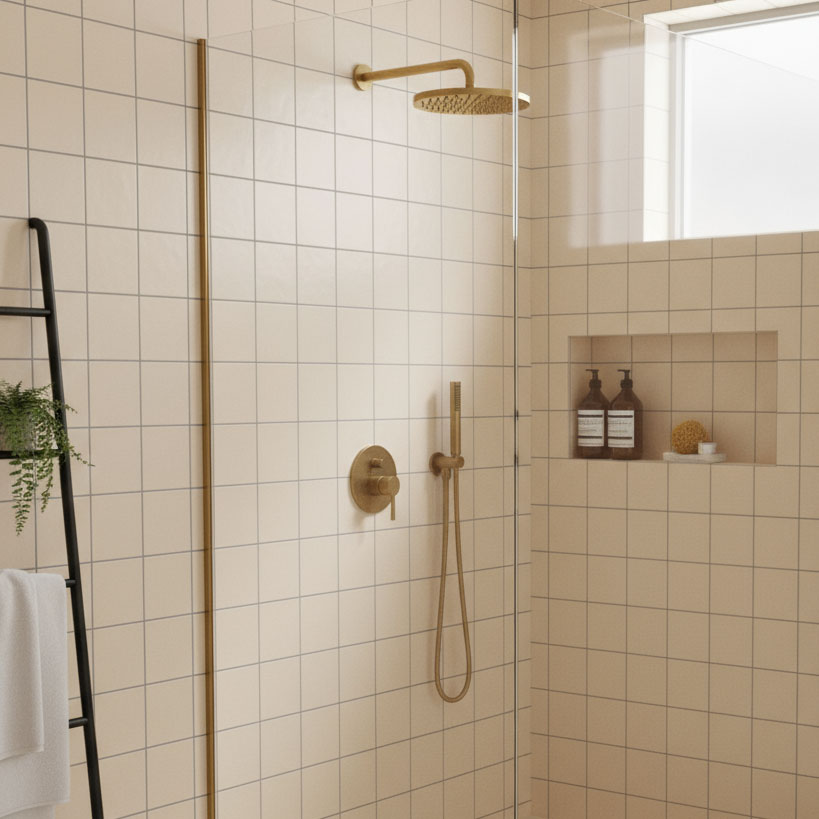25 November 2025
Think all tiles perform the same? Not quite. From bathroom floors to busy public walkways, every space demands something different, which is where Australian tiling standards come into play. These standards set the benchmark for how tiles are tested, rated and installed, covering everything from slip resistance and water absorption to overall durability.
In this article, we’ll break down the main tile performance ratings, including slip resistance, wear rating, and water absorption, and show how each applies to real-world spaces. Whether you’re an architect, builder or homeowner, understanding tiling Australian standards makes it easier to choose tiles that not only look good but perform beautifully for years to come.
Table of Contents
Why Tile Performance Ratings Matter
What do you really want out of a tile? Aesthetics or performance? It’s possible to have both, which is why tile performance ratings matter. Specifiers, builders and clients use them because they indicate how much your tiles can resist slippage, scratching, moisture, breakage and foot traffic. Additionally, there are various tiling Australian Standards which require specific performance ratings as part of their specifications to ensure the tiles are safe, consistent, and reliable.

Understanding Australian Standards for Tiles
There’s more than one Australian Standard that applies to tiling. Some key ones are:
-
AS 4586 – Slip Resistance Classification of New Pedestrian Surface Materials
This standard helps architects, engineers, builders and facility managers assess how slip-resistant a surface is. It includes several testing methods, such as:- Wet Pendulum Test Method
- Oil-Wet Inclining Platform Test Method
Results from these tests are used to classify tiles based on their suitability for different environments.
-
AS ISO 13006 – Ceramic Tiles: Definitions, Classifications, Characteristics and Marking
Defines key terminology and sets out the classifications, characteristics and marking requirements for ceramic tiles of first commercial quality. -
AS ISO 10545 – Ceramic Tiles (Series)
A series of test methods used to assess tile performance, including wear, hardness, and water absorption, which is essential for ensuring tiles meet durability and moisture standards. - AS 4459 – Methods of Sampling and Testing Ceramic Tiles (Series)
Outlines methods for assessing various ceramic tile characteristics, such as dimensions and surface quality. -
AS 3958 – Installation of Ceramic and Stone Tiles
Provides practical guidance on background preparation, adhesives, fixing methods, and installation procedures.
A thorough understanding of these tiling Australian standards is vital for compliance with projects in commercial areas or public spaces, where performance and safety requirements are tightly regulated.
Key Tile Performance Ratings Explained
Tile Performance Ratings explain a tile’s suitability for various uses. They are primarily based on the tile’s durability and slip resistance.
Slip Resistance Ratings (P & R)
The key slip resistance tests are:
-
Wet Pendulum Test (P rating)
This measures the slip resistance of the floor’s surface under wet conditions. It utilises a pendulum device with a spring-loaded rubber slider, which simulates the action of a shoe heel striking the surface. This determines the tile’s Slip Resistance Value (SRV). The classifications range from P0 to P5, with P5 offering the greatest slip resistance. -
Oil-Wet Inclining Platform Test (R rating)
Its purpose is to determine the slip resistance of tiles subjected to oil spills or grease. A wet/oily surface is simulated, and the angle of the surface is gradually increased until the test subject begins to slip. The classifications range from R9 (lowest) to R13 (highest) slip resistance.
Abrasion Resistance
Tiles are rated for their abrasion resistance, which indicates how well they stand up to foot traffic and everyday wear. In Australia, AS ISO 13006 provides guidance for classifying the abrasion resistance of glazed tiles, while testing is carried out under the AS ISO 10545/AS 4459 series to simulate surface wear and determine suitability for different applications. Glazed tiles are grouped into abrasion classes, ranging from Class 0, not recommended for floors, through to Class 5, suitable for areas with heavy pedestrian traffic. For unglazed tiles, abrasion is tested using a deep abrasion test. Instead of a class rating, this test measures how much material wears away under friction, giving a good indication of long-term durability.
If you’re selecting tiles for busy areas such as entryways, kitchens, or commercial spaces, considering abrasion resistance is key. It helps ensure the tiles you choose maintain their finish and performance over time.
Water Absorption (Porosity & Suitability)
Water absorption measures how much moisture a tile can take in, which determines its suitability for different environments. Under the AS ISO 10545.3 & AS ISO 13006 standards, tiles are generally classified by absorption as follows:
- There are three main water-absorption groups by broad category: low (Group I), medium (Group II), high (Group III).
- Within those, the groups are subdivided depending on whether the tile was extruded (A) or dry-pressed (B).
- The water absorption ranges help define how “porous” or “dense” a tile is. Lower Ev = less water absorption and more vitrified / dense.
- Ev ≤ 0.5%
- 0.5 ≤ Ev ≤ 3%
- 3% ≤ Ev ≤ 6%
- 6% ≤ Ev ≤ 10%
- Ev > 10%
In short, the lower the absorption rate, the denser and more water-resistant the tile is.
How to Match Tile Ratings to Specific Zones
The first step is to assess each zone’s purpose, traffic levels and exposure to moisture or spills.
- High-traffic areas: For outdoor/public walkways and high-traffic commercial interiors, consider a more durable tile with a high abrasion class (Class 4–5). For slip resistance under heavy traffic, consider a rating of P3 or higher using SA HB 198 for guidance.
- Wet areas: Such as bathrooms, can have a lower abrasion resistance rating. However, they must have a low water absorption of 3% or less, and slip rating should be considered.
- Barefoot areas: For pool surrounds, consider a tile with a slip resistance of a P4 or P5 rating (Wet Pendulum Test).
- Entryways and transitional spaces: Moderate abrasion resistance (Class 3–4) and a slip rating of P3 or P4, balancing durability and safety, and considering SA HB 198 for slip guidance.


Common Specification Mistakes to Avoid
Some common problems to avoid are:
- Over or under-specifying your tile’s performance ratings based on assumptions, without fully researching the conditions and usage.
- Ignoring factors such as local climate and any water absorption requirements.
- Misreading slip test results. This could result from confusion between the three different types of slip resistance tests (P0 to P5, R9 to R13).
- Specifying substitutions that don’t match the conditions, which can result in compliance issues.
How Johnson Tiles Supports Performance-Led Specification
We provide our technical library with detailed product information. You can also filter tiles by their slip rating on our website and then clicking the “All filters” button.
If you don’t have a thorough understanding of all the modern tiling Australian Standards and performance tests, we can help! You can access guides, FAQs and tutorials on our website or contact us for support from our specification team.
Ready to Specify with Confidence?
At Johnson Tiles, we specialise in helping owners, interior designers, architects, specifiers, resellers, contractors, and builders to select the right tiles for the right zones.
Browse our tiles by performance, including slip, wear, and absorption ratings, and specify your tiles with confidence!


This information is for general guidance only; always consult the relevant Australian Standards for specific requirements.


